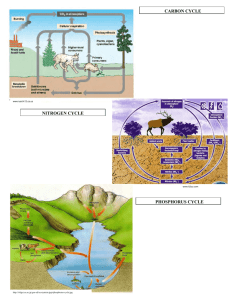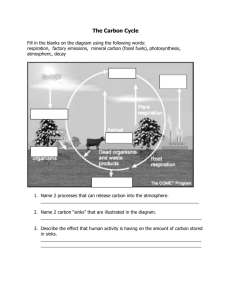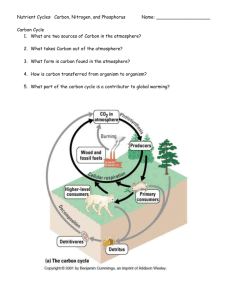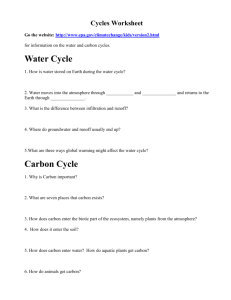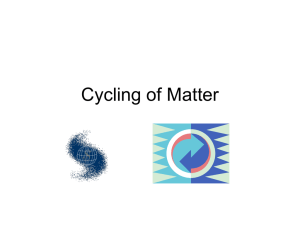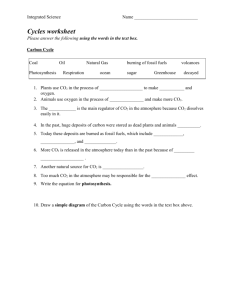Biogeochemical Cycles
advertisement
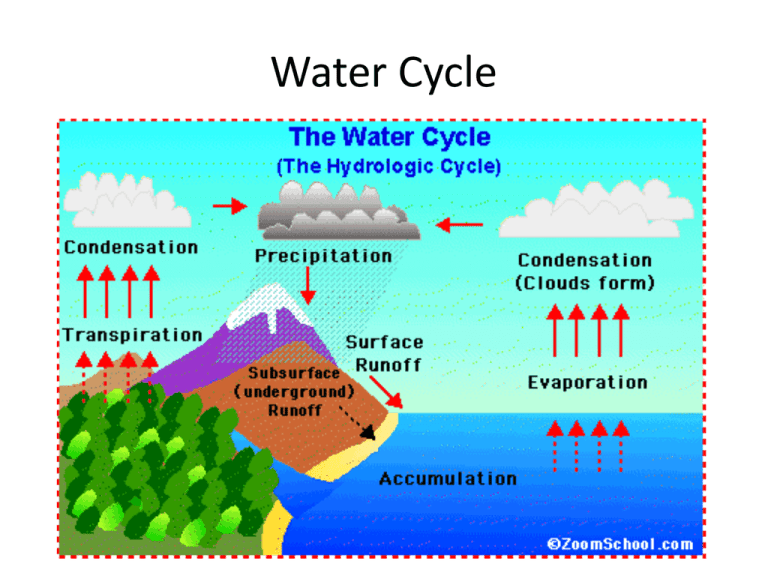
Water Cycle Water Cycle • Transpiration: Excess water is evaporated off the leaves of plants. • Evaporation: Water in oceans, lakes, and ponds changes from liquid water into water vapor and is taken into the atmosphere. • Condensation: Water vapor in the earth's atmosphere turns into liquid water and a cloud is formed. • Precipitation: The liquid water falls from the sky towards the earth surface (could be rain, snow, hail. sleet, etc). • Run off: Water runs towards rivers, lakes and oceans. Carbon Cycle Carbon Cycle • Photosynthesis and Cell Respiration are the two key processes of the carbon cycle. In photosynthesis, carbon atoms are transformed from carbon dioxide into glucose. In cell respiration, carbon atoms stored in glucose are transformed back into carbon dioxide and released into the atomosphere. These transformations are made so that energy can be transformed. • Organic Carbon: Carbon atoms found in living or once-living organisms. • Mineral carbon: Carbon found in rocks or soil. • Atmospheric CO2: Carbon dioxide found in the air. Nitrogen Cycle • Plants and animals need nitrogen to grow. As shown in the pie chart above, a large majority of Earth's atmosphere is made up of atmospheric nitrogen (N2). However, this nitrogen is not usable to plants. Plants are only able to use nitrogen in the form of nitrate. Therefore, nitrogen must be "fixed," or transformed from atmospheric nitrogen to usable nitrogen (nitrate). This is done by bacteria in the soil. Nitrogen Cycle Phosphorus Cycle • Phosphorus is an important element for all forms of life. As phosphate (PO4), it makes up an important part of the structural framework that holds DNA and RNA together. Phosphates are also a critical component of ATP, the cellular energy carrier. Like calcium, phosphorus is important to vertebrates; in the human body, 80% of phosphorus is found in teeth and bones. Phosphorus Cycle • The phosphorus cycle differs from the other major biogeochemical cycles in that it does not include a gas phase; although small amounts of phosphoric acid (H3PO4) may make their way into the atmosphere, contributing, in some cases, to acid rain. The water, carbon, nitrogen and sulfur cycles all include at least one phase in which the element is in its gaseous state. Very little phosphorus circulates in the atmosphere because at Earth's normal temperatures and pressures, phosphorus and its various compounds are not gases. The largest reservoir of phosphorus is in sedimentary rock. Phosphorus Cycle • It is in these rocks where the phosphorus cycle begins. When it rains, phosphates are removed from the rocks (via weathering) and are distributed throughout both soils and water. • Plants take up the phosphate ions from the soil. The phosphates then moves from plants to animals when herbivores eat plants and carnivores eat plants or herbivores. • The phosphates absorbed by animal tissue through consumption eventually returns to the soil through the excretion of urine and feces, as well as from the final decomposition of plants and animals after death..

